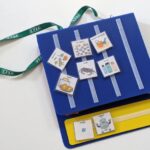Emma* has been using AAC since she was three years old. Born with a physical condition that made verbal communication difficult, and on top of that being diagnosed with Autism and Epilepsy meant a tricky start in life. Whilst Emma now is able to use speech most of the time, she reverts back to PECS regularly as she finds speech very difficult after she has had a seizure.
We recently interviewed Emma to find out what it is really like to communicate with PECS user. She takes us through the highs and lows of using AAC and what it is like using PECS in the community. She also has some great advice for those implementing PECS with their learner.
Q: There is a debate currently about the use of people first v’s diagnosis first language in the autism community. Do you reference yourself as an autistic adult or an adult with autism. What do you prefer others to reference you as?
A: I really don’t care, I think people get too hung up on terminology sometimes, and that makes people scared to actually ask! I have no preference.
Early Years
Q: What age were you when you first started using PECS? Was it your first communication system?
A: I was born with a narrow and thickened trachea and oesophagus, which obviously affected the larynx and that affected speech production and also things like swallowing. So, they knew from a very early age that it was going be something that I would struggle with, and then at the age of 3, I was diagnosed with autism as well. So both of those combined meant that they needed to find me a communication method. I was born in the early 80s, the first thing I was given was photos to be used in a picture exchange type of way as well as labelling items around home so you can do matching and stuff like that. Then photos progressed onto symbols. It was quite early on, and it is one of the first things I remember.

A: Yeah, because obviously growing up even using PECS and signing as well, not everybody knows how to use that so you’re sometimes in a situation where somebody can’t understand you and that can lead to problems. So people try and second-guess what you want or you need. Then they get it wrong so you have to try and communicate further to correct them, people make assumptions about what you want and give you the wrong thing. They don’t come back and check to see if they’ve got it right. You kind of get looked over and it is true that those who shout the loudest get heard the most. If you can’t shout you don’t get heard. Also, when communicating with someone using AAC you listen with your eyes as well as your ears – so if anybody gets distracted and somebody is trying to sign to them or hand over a symbol it can go unnoticed!
As a child you have such a short attention span that if a communication attempt does go unnoticed you just feel like giving up. No one likes failure – the more times that somebody fails because the communication partner isn’t paying attention, the less likely they are to try again in the future. Looking back I can see that all the time you know, it’s what I did as a kid. You need an instant feeling of gratification because that’s what encourages you to keep going.
ABA Therapy
Q: Who implemented PECS with you first? Was it at school or at home?
A: It was the speech and language therapist, alongside an ABA therapist.
Q: So, you had an ABA therapist. There is quite a debate going on just now about that. Some people saying that the ABA therapy that they had as a child has affected them as an adult. Do you have any thoughts about that?
A: People do have really strong feelings about it, people have even told me that I’m brainwashed because I didn’t experience it badly, and that I’m oblivious to how bad it was! But for me it wasn’t, for me it was just fun, you know it was hard work – but school is hard work for any child. I had to do an exchange to get what I wanted, but that’s like asking a child to say please and thank you before they get a biscuit or whatever it is they have asked for. For me it was a positive experience, it gave me a voice. The ABA people worked closely with the PECS people to facilitate that skill with me. I was taught signs as well but of course not everybody can understand sign language, but because you have got the picture and the word on the symbol anybody can use it.
Q: Were your family and school on board with using PECS, or were they concerned that it might stop you from developing speech?
A: Oh yes there were concerns for sure. When I was at secondary school my speech still wasn’t very clear and also I would stutter. Because my speech was late developing, anything that was out of the ordinary, that made me really excited or anxious would affect my speech. Speech was the first thing to go when my emotions were high. That’s why I kept my other communication methods but my teacher said that, and I remember her exact words “I would do better in real life, if I didn’t need little pictures or do silly things with my hands” – referring to the signing. I think because she was a teacher and I was that much older everybody agreed that maybe I should ditch symbols but that ended up with me failing school to some extent because I didn’t have it to fall back on. I also used a visual timetable which is massively beneficial to me and suddenly it was taken away from me. And also just because I could verbally answer questions, say yes and no and so forth when it came to more complex subjects like saying if I was in pain or feeling emotions that’s where I needed to fall back on PECS because that’s what I was comfortable using.
At the end of the day I think it’s more important that somebody could communicate what they need or want rather than the way in which they do it, it doesn’t have to be speech. Speech isn’t the be all and end all of everything! I found that symbols acted as prompts to speech as well, if you have word finding difficulties such as verbal dyspraxia having that symbol helps you link it in your brain. I would say that my brain is like a filing cabinet of symbols. When somebody says a word, in my mind symbols fly across until I see the symbol that is associated with the word that somebody is just said. If somebody says to me ”oh that’s awesome” I see the thumbs up symbol. I don’t think in words I think in symbols and hand shapes. Over time you have to expand your vocabulary as well, in my 20s everybody suddenly started describing things as “sick” meaning good, but in my mind when I hear the word sick I see the symbol of somebody vomiting into a bucket! So I do have some funny overlaps as language develops.
using PECS as a child
Q: Did you have peers at school that used PECS? If so, did you interact with each other using PECS?
A: I was schooled both in special school and mainstream and found that my peers in mainstream were more interested in using AAC then in special school. I think that is because in special school the communication was all centered around the pupil with the teacher or the teaching assistant rather than pupil to pupil. The class sizes were so small, and with such high ratios of adults to children the opportunity for peer-to-peer interaction was quite limited. Whereas in mainstream school, in my class I was the only kid with communication difficulties, if a friend wanted to communicate with me they had to use my system. There wasn’t a high enough level of staff to have somebody there as a 1:1 for me, so if I needed something or some help I had to ask a peer using PECS. So surprisingly, there was actually more opportunity to interact with peers using AAC in mainstream then there was in the specialist school I went to.
Q: Did you use PECS in the community – outside of school and the family home, in shops and leisure activities for example? What was the reaction from people in the community? Did they struggle with it?
A: Some people definitely saw it as a novelty, you know what people are like they see something new and want to know what it is. That was quite useful in some ways, it made people happy to engage and ask me “what are you doing?” When I was younger it was always quite useful to have somebody with me you could explain to the person I was communicating with that I had autism and was using PECS, it made them receptive to me. As you grow up and become more self-aware and self-conscious, there was the worry that I might hand over sentence strip and they just smile and hand it back to me!
Q: How far did you get through the protocol, did you use PECS for commenting and more advanced concepts, or just for requesting?
A: Yes in later childhood and teenage years I was introduced to more complex concepts and colours for example. I was also asked to comment on a TV show or a book.
Q: In the beginning physical prompting is used to teach the leaner to exchange a picture, how was that for you? Do you remember having a physical prompter and do you have any objections to having had that?
A: I think personally it’s necessary, and I know that not everybody will share that view, but for me I needed to be physically shown what to do. To me you wouldn’t say to somebody okay say “supercalifragilisticexpialidocious” you would break it down into various steps, show the person how to make the face shapes of the various different syllables, and make the face and mouth shapes which is what the speech therapist did for me when I first started speaking. When I first started using PECS I needed a physical prompt to help me make the link between handing over a picture and receiving the item, it didn’t take long for me to realise that when I handed over a symbol I would then get the Smarties or the raisins or the toy, but I definitely needed that prompt in the first place. Also when I was older I didn’t always want to use it, I remember posting all the symbols out through the letterbox of the front door because I didn’t want them anymore!
Also sometimes I needed that reminder to use it when I was in a new place. So I would be used to using it at school and at home but then if I was in a restaurant for the first time I would probably need to be prompted to use it because I had never done it there before. I did also forget sometimes how to do it or loose confidence in new places. It was difficult to transfer skills sometimes.
Q: Did you recall having any difficulties using PECS?
A: Yes a couple of things spring to mind, firstly teachers or whoever not having backup symbols. Symbols get lost all the time or get damaged. Those primary ones such as toilet and basic needs really need to have backup symbols, they are so important, you really need a spare set. The second one is to never take a PECS book off somebody! You wouldn’t gaffer tape your child’s mouth shut – you would probably go to prison if you did. I’m sure that’s abuse! Even if they’re asking for ice cream 20 times a minute you don’t take a PECS book away or put it on the top shelf so they can’t reach it.
I sometimes was a bit lazy and would only tap the symbols rather than actually exchanging, that was accepted in the lower phases but not once I had the skills to do it properly.
Using PECS as an Adult

A: No I haven’t that’s right, I still have symbols and visuals around the house to remind me to do things like have a drink and lock the front door. I have epilepsy and when I have a seizure and come round speech is the first thing to go, I think it’s because I developed it so late. I have all the words in my brain, but after a seizure I just can’t get them out through my mouth. So, I need an alternative – that would either be signing or PECS.
Q: So I’m guessing that as seizures don’t run on a timetable that you must always carry a PECS book with you when you’re out and about?
A: Yes that’s right, and as I’ve got older for example when I go to a nightclub or something I don’t take a full PECS book with me. I tend to take a few small symbols and a tiny sentence strip in a little sandwich bag that I can just slip in my pocket. Sadly they don’t last as long as proper PECS book though – especially if you spill your drink on them!
Q: Have you ever used a high-tech picture system such as a speech generating device or have you always stuck to a communication book?
A: I have a right mixture of stuff, I have an iPad with quite a few different apps.
Next month you can read part two of this interview where we talk about the transition to adult services and Emma’s experience of having a job and being an AAC user.
*name has been changed to protect their identity
By Louise Hotchkiss
© Pyramid Educational Consultants
